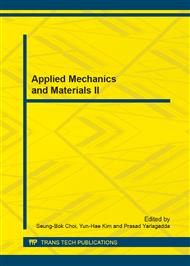[1]
E. Hoek, E.T. Brown, Underground Excavations in Rock, Inst. of Mining and Metallurgy, London, (1980).
Google Scholar
[2]
B.J. Carter, E.Z. Lajtai, A. Petukhov, Primary and remote fracture around underground cavities, Int. J. Numer. Anal. Meth. Geomech. 15 (1991) 21–40.
DOI: 10.1002/nag.1610150103
Google Scholar
[3]
B.J. Carter, E.Z. Lajtai, Y. Yuan, Tensile fracture from circular cavities loaded in compression, Int. J. Fract. (57) (1992) 221–236.
DOI: 10.1007/bf00035074
Google Scholar
[4]
E.J. Sellers, P.A. Klerck, Modelling of the effect of discontinuities on the extent of the fracture zone surrounding deep tunnels under pressure, Tunnelling Underground Space Technol. 15 (2001) 463–469.
DOI: 10.1016/s0886-7798(01)00015-3
Google Scholar
[5]
M. Lee, B. Haimson, Laboratory study of borehole breakouts in Lac du Bonnet granite: a case of extensile failure mechanism, Int. J. Mech. Min. Sci. Geomech. Abstr. 30 (7) (1993) 1039–1045.
DOI: 10.1016/0148-9062(93)90069-p
Google Scholar
[6]
R.T. Ewy, N.G.W. Cook, Deformation and fracture around cylindrical openings in rock–II. Initiation, growth and interaction of fractures, Int. J. Mech. Min. Sci. Geomech. Abstr. 27 (5) (1990) 409–427.
DOI: 10.1016/0148-9062(90)92714-p
Google Scholar
[7]
Z. Zheng, J. Kemeny, N.G.W. Cook, Analysis of borehole breakouts, J. Geophys. Res. 94 (B6) (1989) 7171–7182.
DOI: 10.1029/jb094ib06p07171
Google Scholar
[8]
B.J. Carter, Size and stress gradient effects on fracture around cavities, Rock Mech. Rock Engrg. 25 (3) (1992) 167–186.
DOI: 10.1007/bf01019710
Google Scholar
[9]
P.A. Klerck a, E.J. Sellers b, D.R.J. Owen. Discrete fracture in quasi-brittle materials under compressive and tensile stress states. Comput. Methods Appl. Mech. Engrg. 193 (2004) 3035–3056.
DOI: 10.1016/j.cma.2003.10.015
Google Scholar
[10]
Belytschko, T., and T. Black, Elastic Crack Growth in Finite Elements with Minimal Remeshing, International Journal for Numerical Methods in Engineering, vol. 45, p.601–620, (1999).
DOI: 10.1002/(sici)1097-0207(19990620)45:5<601::aid-nme598>3.0.co;2-s
Google Scholar
[11]
Melenk, J., and I. Babuska, The Partition of Unity Finite Element Method: Basic Theory and Applications, Computer Methods in Applied Mechanics and Engineering, vol. 39, p.289–314, (1996).
DOI: 10.1016/s0045-7825(96)01087-0
Google Scholar
[12]
Elguedj, T., A. Gravouil, and A. Combescure, Appropriate Extended Functions for X-FEM Simulation of Plastic Fracture Mechanics, Computer Methods in Applied Mechanics and Engineering, vol. 195, p.501–515, (2006).
DOI: 10.1016/j.cma.2005.02.007
Google Scholar
[13]
Sukumar, N., Z. Y. Huang, J. -H. Prevost, and Z. Suo, Partition of Unity Enrichment for Bimaterial Interface Cracks, International Journal for Numerical Methods in Engineering, vol. 59, p.1075–1102, (2004).
DOI: 10.1002/nme.902
Google Scholar
[14]
Sukumar, N., and J. -H. Prevost, Modeling Quasi-Static Crack Growth with the Extended Finite Element Method Part I: Computer Implementation, International Journal for Solids and Structures, vol. 40, p.7513–7537, (2003).
DOI: 10.1016/j.ijsolstr.2003.08.002
Google Scholar
[15]
ABAQUS Theory Manual and Analysis User's Manual.
Google Scholar
[16]
Song, J. H., P. M. A. Areias, and T. Belytschko, A Method for Dynamic Crack and Shear Band Propagation with Phantom Nodes, International Journal for Numerical Methods in Engineering, vol. 67, p.868–893, (2006).
DOI: 10.1002/nme.1652
Google Scholar
[17]
Remmers, J. J. C., R. de Borst, and A. Needleman, The Simulation of Dynamic Crack Propagation using the Cohesive Segments Method, Journal of the Mechanics and Physics of Solids, vol. 56, p.70–92, (2008).
DOI: 10.1016/j.jmps.2007.08.003
Google Scholar


